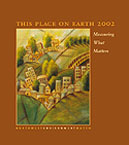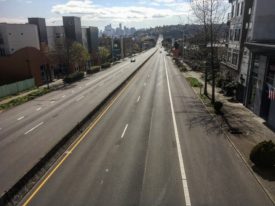“This Place on Earth 2002” looks at the region’s progress in sustainability by assessing trends in ten key areas, from salmon health and spread of sprawl to income distribution and energy efficiency. The report was a first step toward developing a barometer of “true” progress for the region (the Cascadia Scorecard). This excerpt from the introduction explains the need for such alternatives to traditional gauges.
“Growth: Of What, for What?”
In the immediate aftermath of the September 11 terrorist attacks, even in the grip of the world’s rage and grief, one of the media’s most persistent questions was, What was the death toll? It seems a peculiar question. Each individual death was a tragedy incommensurable with any other. For the victims’ families, a precise body count could change nothing.
Still, the question How many deaths? asserted itself as people searched for some quantification of the incomprehensible. In that way, the question was profoundly revealing. Counting things is a deeply human impulse; it’s one way we understand our world.
This Place on Earth 2002: Measuring What Matters is a book about what society counts in its attempt to assess itself and make choices for its future–and how society often doesn’t measure what matters the most to us: whether people and nature are secure and thriving. The book, which assesses ten key environmental and social trends in the Northwest, is also a first step toward better indicators, indicators that can realign people’s actions with their deeper values.
What society currently measures is sometimes a fluke of history, a canonization of the oft repeated: that the Dow Jones industrial average’s every vacillation is reported in excruciating detail by media outlets worldwide is a testament to the self-reinforcing nature of public perceptions. Sometimes society simply relies on indicators that are easy to count or that businesses or public agencies are tallying for their own reasons anyway: hence such regular reports as payroll, sales tax receipts, unemployment insurance filings, profits, commodity production, births, deaths, and housing starts.
But often, what gets counted flows from political power: businesses want to know buyers’ moods, so business associations measure consumer confidence; governments deploy dozens of workers to monitor inflation because financial and labor sectors want to know.
Consider the events of 2001 as they looked on the Gross Domestic Product (GDP) ledger: The Puget Sound earthquake of February looked like a boom in building repairs. The extended spring strike that shut down transit–and increased driving–in Vancouver, BC, showed up as a jump in gasoline spending. The mysterious plant disease that swept up the coast from California to Oregon, killing the states’ revered oaks, looked like a banner year for arborists and tree nurseries. In summer, the catastrophic wildfires of an exceptionally dry season in eastern Oregon and Washington appeared as huge outlays for public and private firefighting.
Then, in September, the World Trade Center attack showed up as a surge in sales of flags, flowers, and relief packages sent East, plus a sudden slackening of spending on air travel and tourism and, later, spending generally.
GDP fails to distinguish between losses and gains, because it only adds and doesn’t subtract. Gutting ecosystems for commodities shows up as a plus in the accounts. So do expensive misfortunes: Whether money is spent on vacations or hospital stays, playground equipment or car wrecks, it’s all the same in the GDP ledger.
Likewise, GDP goes up regardless of whether consumers may regret the purchase (such as spending on alcohol, tobacco, and gambling) or when consumers may regret the need for the purchase (such as spending on car alarms, firearms, gated communities, and private guards). Blind to services provided free by families, friends, and communities, GDP math values an hour of paid daycare more highly than an hour of unpaid parenting and a book from a store more than one from a library.
With its blinkered accounting, the GDP tells only about the growth of economic production, not of economic satisfaction or quality of life. Since 1957, for example, US real GDP per capita has more than doubled, but the share of Americans who describe themselves as “very happy” has remained unchanged at about one-third. Even Simon Kuznets, Nobel Prize-winning economist and inventor of the GDP, warned against treating it as a gauge of progress; in 1962, he wrote, “Goals for ‘more’ growth should specify more growth of what and for what.”
While the GDP measures well the wrong thing, the Dow Jones industrial average just measures badly. The Dow is the undisputed king of stock market yardsticks. In popular consciousness, the Dow is the market; the NASDAQ composite, the S&P 500, and other measures merely color the news. But the Dow is the least-accurate regularly published stock indicator. Not only is its roster of 30 companies assembled without benefit of any particular methodology–two people at Dow Jones & Co. simply pick them–the index is also mathematically spurious. The Dow averages stock prices without attention to the number of shares in circulation.
The Dow’s odd structure is explained by its genesis. Charles Dow, first editor of the Wall Street Journal, created it in 1896, scribbling out the calculations by hand. A short list of stocks and a simple formula let him report his average easily and often. Incorporating market capitalization (the number of shares times the price of each) would have necessitated a lot of multiplying and adding, followed by one gigantic division problem. The world’s most quoted economic gauge may therefore be erroneous because of a fear of long division.
Just as the Dow and GDP deceive us, other indicators also give inaccurate readings. The consumer price index exaggerates inflation (because part of its rise reflects tastes that elevate with purchasing power); the unemployment rate understates unemployment (because it excludes those who have given up on finding jobs); and the poverty rate undercounts the poor (because the US poverty definition is the most miserly standard of basic needs in the industrial world).
The Northwest’s chosen indicators should not be historical flukes, matters of convenience, or perquisites of power. They should spring from the region’s values, its aspirations for the future. Financial security ranks high among those values, so it is fitting that the Northwest monitor its financial capital. But it is not fitting that financial measurements should overwhelm all others in how often they are tabulated; that stock quotes, commodity prices, and other yardsticks of the marketplace should crowd out indicators of community vitality, human well-being, and ecological integrity.
When the region does regularly monitor its environmental and social, along with its economic, performance, however, this place on Earth may yet achieve a way of life that can last–one that nurtures human community while honoring nature’s limits.







